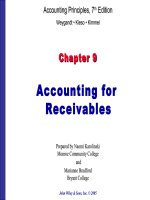Accounting principles 7th kieso kimel chapter 20
Bạn đang xem bản rút gọn của tài liệu. Xem và tải ngay bản đầy đủ của tài liệu tại đây (640.13 KB, 43 trang )
Accounting Principles
7th Edition
Weygandt • Kieso • Kimmel
Chapter 20
Managerial
Accounting
Prepared by Naomi Karolinski
Monroe Community College
and
Marianne Bradford
Bryant College
John Wiley & Sons, Inc. © 2005
CHAPTER 20
MANAGERIAL
ACCOUNTING
After studying this chapter, you should be able to:
1.
2.
3.
4.
5.
Explain the distinguishing features of managerial
accounting.
Identify the three broad functions of management.
Define the three classes of manufacturing costs.
Distinguish between product and period costs.
Explain the difference between a merchandising
and a manufacturing income statement.
CHAPTER 20
MANAGERIAL
ACCOUNTING
After studying this chapter, you should be able to:
6. Indicate how cost of goods manufactured is
determined.
7. Explain the difference between a
merchandising and a manufacturing balance
sheet.
MANAGERIAL ACCOUNTING
BASICS
STUDY OBJECTIVE 1
Management Accounting
• A field of accounting that provides
economic and financial information for
managers and other internal users.
MANAGERIAL ACCOUNTING
BASICS
Activities include:
•
•
•
•
Explaining manufacturing and
nonmanufacturing costs and how they are
reported in the financial statements
Computing the cost of providing a service or
manufacturing a product
Determining the behavior of costs and
expenses as activity levels change
Analyzing cost-volume profit relationships
within a company
MANAGERIAL ACCOUNTING
BASICS
Activities include (continued):
• Assisting management in profit planning and
budgeting
• Providing a basis for controlling costs and
expenses by comparing actual results with planned
objectives and standard costs
• Accumulating and presenting relevant data for
management decision making
COMPARING MANAGERIAL AND
FINANCIAL ACCOUNTING
ETHICAL STANDARDS
FOR MANAGERIAL
ACCOUNTANTS
•
•
Managerial Accountants have an ethical
obligation to their companies and the public.
The Institute of Management Accountants
(IMA) developed a code of ethical standards
which divides the managerial accountant’s
responsibilities into 4 areas:
–
–
–
–
Competence
Confidentiality
Integrity
Objectivity
MANAGEMENT FUNCTIONS
STUDY OBJECTIVE 2
1. Planning
2. Motivating and Directing
3. Controlling
PLANNING
Planning requires management to:
• Look ahead
• Establish objectives
• Add value to the business under its control (as
measured by company’s stock price or its
potential selling price)
DIRECTING AND MOTIVATING
Directing and Motivating requires management to:
•
•
•
•
Coordinate a company’s activities
Implement planned objectives
Select and train employees
Prepare organization charts
CONTROLLING
Controlling requires management to:
• Keep the firm’s activities on track
• Determine whether planned goals are being met
• Decide what changes are needed if goals are not
met
MANAGERIAL
COST CONCEPTS
•
•
•
•
Managers need information related to
costs, such as:
What costs are involved in making the
product or providing a service?
If production volume is decreased, will
costs decrease?
What impact will automation have on total
costs?
How can costs best be controlled?
MANAGERIAL
COST CONCEPTS
• Manufacturing: Activities and processes
that convert raw materials into finished
goods.
• Manufacturing Costs include:
– Direct materials
– Direct labor
– Manufacturing overhead
Managerial accounting:
a. is governed by generally accepted accounting principles.
b. places emphasis on special-purpose information.
c. pertains to the entity as a whole and is highly
aggregated.
d. is limited to cost data.
Chapter 20
Managerial accounting:
a. is governed by generally accepted accounting principles.
b. places emphasis on special-purpose information.
c. pertains to the entity as a whole and is highly
aggregated.
d. is limited to cost data.
Chapter 20
CLASSIFICATIONS OF
MANUFACTURING COSTS
STUDY OBJECTIVE 3
MANUFACTURING
COSTS DIRECT
MATERIALS
Raw materials
• The basic materials and parts that are used in the
manufacturing process
• Raw materials physically and directly associated
with the finished product are called direct
materials
Materials
INDIRECT MATERIALS
•
•
Indirect Materials are raw materials which
cannot be easily associated with the finished
product.
•
Not physically part of the finished product
•
Cannot be traced because their physical
association with the finished product is too small
in terms of cost
Accounted for as part of Manufacturing
Overhead
LABOR
• Direct Labor: The work of factory employees which
is physically and directly associated with converting
raw materials into finished goods.
• Indirect Labor: Efforts which have no physical
association with the finished product or it’s
impractical to trace the costs.
• Indirect Labor: Classified as Manufacturing
Overhead
Factory
Labor
MANUFACTURING
OVERHEAD
•Consists of costs that are indirectly associated
with manufacturing the finished product.
•Includes:
• Indirect materials
• Indirect labor
• Depreciation on factory buildings and machines
• Insurance, taxes, maintenance on
factory facilities
Manufacturing
Overhead
PRODUCT COSTS VERSUS
PERIOD COSTS
STUDY OBJECTIVE 4
Product costs:
• include each of the manufacturing cost elements
(direct materials, direct labor, and manufacturing
overhead)
• are a necessary and integral part of producing the
finished product
• are recorded as inventory and not expensed to cost of
goods sold until the time of sale
PRODUCT COSTS VERSUS
PERIOD COSTS
Period costs:
•
•
•
•
•
are identifiable with a specific time period
are nonmanufacturing costs
are not included in inventory
include selling and administrative expenses
are deducted from revenues in the period incurred
PRODUCT VERSUS
PERIOD COSTS
Product Costs
Manufacturing
Costs
{
Direct Materials
Direct Labor
Manufacturing
Overhead
Period Costs
Nonmanufacturing
Costs
{
Selling Expenses
Administrative
Expenses
Merchandising versus
Manufacturing Income
Statement
STUDY OBJECTIVE 5
The income statement for a manufacturer
is similar to that of a merchandiser except
the cost of goods sold section.









